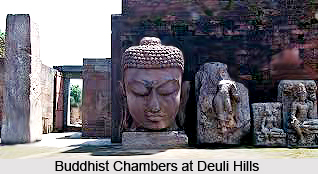 Deuli hills are situated in the Khordha district of Odisha, at the confluence of Kimiria and Brahmani rivers. On the southern side of the hills, five rock-cut Buddhist chambers have been excavated which belong to ancient times. These caves comprise both single and double chambered cells and have been found in strategic locales which let these chambers to exploit free passage of air to the maximum extent. The rock cut caves found in the hills are the testaments of pre monastic movement that flourished in the state of Orissa during ancient times. Since the time of Lord Buddha, taking shelter in the caves during rainy season was frequently practiced.
Deuli hills are situated in the Khordha district of Odisha, at the confluence of Kimiria and Brahmani rivers. On the southern side of the hills, five rock-cut Buddhist chambers have been excavated which belong to ancient times. These caves comprise both single and double chambered cells and have been found in strategic locales which let these chambers to exploit free passage of air to the maximum extent. The rock cut caves found in the hills are the testaments of pre monastic movement that flourished in the state of Orissa during ancient times. Since the time of Lord Buddha, taking shelter in the caves during rainy season was frequently practiced.
During the early period, Buddhist monks preferred to spend the rainy season in secluded places from where the nearby villages and towns were easily reachable for the procurement of food. In the Mahabhaga, which is a Vinaya Buddhist text and narrates the rules of conduct for the Buddhist monks, it has been prescribed by Lord Buddha about the retreat of the monks to specific places during monsoons. Buddhist and Jain sources mention that monks and nuns were expected to follow this practice of living in caves to avoid trampling of worms and insects which propagate during this season. Another Vinaya text, known as Chullabhaga, mentions four kinds of `lenas` or dwellings for the communities of monks called `sanghas`. These types are `guha`, `hammiya`, `pasada` and `vihara`.
The caves have numerous inscriptions, which illuminate the fact that the excavations of the caves were supported by various donations made by the rulers which signifies their patronage towards the community of monks. Apart form this, high rank officers and lay worshippers also contributed for the dwellings and other requisites of the `sanghas`.
This article is a stub. You can enrich by adding more information to it. Send your Write Up to content@indianetzone.com



















